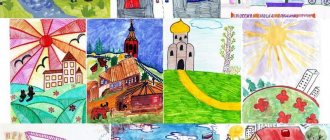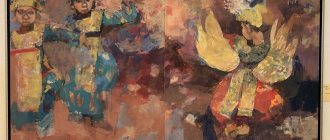Methodology for introducing preschoolers to the history of their native land
It is important to note that the work being carried out is effective only if children actively interact with adults (parents and educators). Thus, excursions, joint holidays and quizzes create powerful motivation for learning in children, providing the emotional background against which the assimilation of quite complex information occurs easily and naturally.
Thus, the created conditions act as a sociocultural environment that creates optimal conditions for the formation of a holistic picture of the world in children, the education of patriotism, the foundations of citizenship, as well as interest in their small homeland.
4. Practical stage
The original work plan included:
Cooperation with the school library, with the school museum, with the rural cultural center.
Excursions along the streets of the village, to the monuments.
Meetings with interesting people.
Educational games, quizzes, competitions, musical and literary evenings.
Collection of materials about the history of the village, its streets, and kindergarten.
Exhibitions of drawings, photographs, crafts on local history topics, collecting collections.
To increase the level of children's knowledge about their native village and their motivation for further activities, local history activities were included in the work plan. Together with the children, we took walks around the village, paid attention to the beauty and cleanliness of the streets, buildings, flower beds, and noted what new buildings and playgrounds had appeared. The children were interested to find out why this or that street has such a name, what interesting buildings and institutions are there, etc. The children also visited the fire department, library, school, post office, etc. Children got acquainted with the professions of people, with the work of their parents. Took part in the inter-district event “My Small Motherland!” on the territory of KFOR village. Zhediaevka.
All this helped me get to know my village and profession better. The work of people, value and respect this work. On May 9, children annually lay flowers at the monument to fallen heroes, participated in the “Soldier’s Triangle” event, visited WWII veterans and war children, and together with their parents took part in the “Immortal Regiment” procession.
In my work I used press materials from the Ulyanovsk region (magazines “Simbik”, “Monomakh”), as well as the publication by Yu. Mordvinov “A Look into the Past” (from the history of the villages of the Staromainsky district), which the author painstakingly collected in archives and libraries for many years information and facts scattered across different funds.
Environmental education is an integral part of the project. Nurturing love for one’s native land is inextricably linked with caring for nature. The nature of the Staromainsky district is amazing, absolutely amazing in its beauty. The most beautiful rivers are here. They are famous for their mushrooms and berries. The cleanest springs and ponds rich in fish, unique natural monuments. The task of adults is to help them see all this and instill pride and love for their city, their native land. Therefore, we recommend that parents spend more time in nature with their children. These are exhibitions of crafts made from natural materials, exhibitions of drawings “Together we draw autumn (winter, spring, summer), participation in charity events, environmental campaigns (greening areas of the kindergarten), trips to the river, meadow, forest clearing, participation in nature festivals held in kindergarten. All this work not only taught sensitivity, kindness, and responsiveness, but also served to unite the children and developed their activity and creative abilities.
MAGAZINE Preschooler.RF
Article “The concept of work to introduce children to their native land”Pedagogical concept of the teacher of the first qualification category of MADOU "Kindergarten No. 29 of a combined type" of Petropavlovsk-Kamchatsky Oksana Vladimirovna Polishchuk on the topic: "Organization of local history work with preschoolers .
Justification of the relevance and prospects of the experience. Its importance for improving the educational process.
Homeland. Fatherland. Fatherland. Father's land. This is what people call the land on which they were born, and there is nothing dearer to a person than the Motherland, the beauty of which was once revealed to him as a miracle. We adults need to help the child discover this miracle, introducing him to nature and everyday life, history, and culture of his native land. Getting acquainted with his small Motherland, the child begins to love her and retains a feeling of attachment to her for life.
The relevance of studying local history in modern society is obvious. Local history is one of the most important sources of expanding knowledge about the native land, nurturing love for it, and developing citizenship.
In preschool age, the formation of a person’s character, thinking, and speech occurs, and a long process of forming moral values begins, which underlie love for the Motherland. The love for the homeland of the younger generation begins with a feeling of their native land, their native land. That is why local history work should be carried out already from kindergarten - from the age when the process of socialization and personality formation begins.
In my opinion, a child’s feeling as a patriot should begin with the awareness of himself as a part of his small homeland. Material on local history is a rich source that makes it possible to fill the gaps in the moral education of children that have arisen recently.
The study of local history fosters the desire to be useful to one’s hometown, the place where one was born and raised, and becomes the foundation on which one can cultivate pride in one’s country, one’s region and the desire to actively participate in social processes. Local history work broadens children's horizons and develops children's verbal and visual creativity.
I would like to recall the wonderful words of the famous Russian scientist D.S. Likhacheva: “Local history teaches people not only to love their native places, but also to know about them, teaches them to be interested in history, art, literature, and to improve their cultural level. This is the most popular form of science .
Conditions for the formation of the leading idea of experience, conditions for the emergence and formation of experience.
Introducing preschoolers to the cultural and natural origins of their small Motherland is now becoming one of the priorities.
During childhood, the basic qualities of a person are formed. It is especially important to imbue the child’s receptive soul with sublime human values and to arouse interest in his small Motherland.
I pay special attention to the development of love for their native land, cognitive abilities and needs by introducing children to the flora and fauna, forming children’s interest in folk art, and providing conditions for raising children in the spirit of tolerance.
We all know the proverbs “Great is the world, but there is no warmer land than your own” , “A home is more valuable than gold” , “In your own land the water is sweeter” - these wise words, which have become proverbs and sayings, do not require proof. They were the moral standard, the way of life of our ancestors
What do these words mean for our children? I addressed this question to my students. The answers I received (this is interesting; it’s important to know this in order to respect the history of your ancestors; it’s always interesting where you come from; without knowing the history of your native land you cannot consider yourself a cultured person), allowed me to conclude: the guys are interested in this.
Local history today is becoming an important means of improving the quality of knowledge. Using local history material in the classroom, I noticed that it activates children’s mental activity, allows them to diversify the teaching methods, and participates in the patriotic education of preschoolers.
The main goal of my work in local history is: to form a child’s knowledge about the natural world of his native land, to form realistic knowledge about its objects and phenomena, to teach him to observe, notice, reflect and reason. Actively communicate with nature, acquiring new knowledge, skills and abilities. To introduce the social life of Kamchatka, the life and culture of the peoples inhabiting it, history, literary heritage, symbols.
The following tasks are aimed at achieving this goal:
- Expand the horizons of pupils with new knowledge about the Kamchatka region.
- Foster an emotionally positive attitude towards nature, develop the ability to see and understand its beauty;
- To cultivate a caring attitude towards the animal world, a sense of empathy and belonging to nature.
- Show children the importance of animal biodiversity for humans.
I believe that solving the problems of familiarizing preschoolers with their native land will be facilitated by:
- creation in the group of an expanded center for local history with various didactic and gaming aids;
- early start of education for preschoolers;
- inclusion of elements of local history in all types of children’s activities.
The development of work on local history should not be carried out periodically, but systematically and step by step.
The development of work on local history is a task on a federal scale, important for the whole of Russia and for any corner of our Motherland. It is most effective if organized as a holistic system. I study local history not only in class, but also in my free time.
Thus, the organization of local history activities is the introduction of a little person into the world of his small homeland.
Technology of experience. System of specific pedagogical actions, content, methods, techniques of education and training
Kamchatka nature is full of charm not only in itself.
Introducing the children to the Kamchatka region, I talked about what it is famous for: Volcanoes, nature reserves, extraordinary nature, animals. I pay a lot of attention to getting to know the Kronotsky Nature Reserve.
I made a plan for introducing children to the Kamchatka Territory, and a plan for introducing them to the Kronotsky Nature Reserve. I have selected a lot of literature and didactic material to familiarize children with the Kamchatka region.
The leading form of work to get acquainted with the native land is classes on cognitive development.
Of no small importance in the development of children's activity is a well-equipped, rich subject-development environment, which stimulates the child's independent activity and creates optimal conditions for intensifying the course of self-development. In this regard, in the group, I created a center for local history, where conditions were created for joint and independent activities of children. The center has a variety of material: thematic albums about Kamchatka, about the city of Petropavlovsk-Kamchatsky, about the villages of the Kamchatka Territory, photographs of attractions, material on the Nature Reserves of the Kamchatka Territory.
The center has a variety of equipment. A competent combination of materials and equipment in the corner helps expand the cognitive, communicative, artistic and aesthetic experience of children.
A special place in local history work is occupied by the didactic means of museum pedagogy, which help to recreate in the minds of children pictures of the past of our region, to introduce household items, tools, and clothing of our ancestors. Natural history exhibitions show the richness and diversity of the flora and fauna of Kamchatka.
An important method of presenting information to children, especially of a historical nature, is an educational story. Considering that preschoolers are characterized by visual-figurative thinking, it is necessary to accompany it with visual material: photographs, illustrations, slides, diagrams, as well as ancient household items.
Presentations were selected and developed for each lesson to familiarize children with their native land and the Kronotsky Nature Reserve:
Presentations about the Kamchatka region:
- Volcanoes of Kamchatka.
- City `s history.
- World of Kamchatka Wildlife.
- Peoples of the North.
- Our town.
- Lakes of Kamchatka.
- Monuments of Kamchatka
- Kamchatka fashion, etc.
- Animals of Kamchatka.
Presentations about the Kronotsky Nature Reserve:
- History of the Kronotsky Nature Reserve.
- Who works in the reserve.
- Valley of Geysers.
- Death Valley.
- Volcanoes of the Kronotsky Nature Reserve.
- Volcano Uzon.
- Brown bears.
- Wild reindeer.
- Kronotskoye Lake.
- Marine mammals.
- Fir grove.
- Plants of the Kronotsky Nature Reserve, etc.
Films about the Kronotsky Nature Reserve and the Kamchatka Territory were also selected.
Taking into account the leading activities of children, I widely use various types of games in local history work. She has developed a number of didactic games to get acquainted with the Kamchatka region ( “Where I am” , “Find out and tell” , “When it was” ), the nature of the Kamchatka land ( “Ecological traffic light” , “Who lives in the forest”, “Edible - inedible” and etc.), the labor of fellow countrymen ( “Who worked?” , “What is Kamchatka land rich with?” ).
The work of introducing the enterprises of the region and the work of fellow countrymen develops into an interesting long-term role-playing game in which children apply their knowledge and already accumulated life experience ( "Sailors" , "Fishermen" , "Tour Guide" , "Construction" , etc.)
One of the forms of working with children is productive creative activity, which includes drawing, appliqué, and manual labor. It allows you to consolidate the acquired knowledge of children and reflect the emerging attitude towards the subject being studied. I present the results of children’s productive activities in the form of thematic exhibitions.
Positive emotions play a significant role in the formation of moral and patriotic feelings in preschool children. A national holiday, a local history quiz, a thematic entertainment (about work, native nature) is the logical and emotional conclusion of the work on each of the developed topics.
I held such events as “Hololo Holiday” , quiz “Love and Know the Kamchatka Territory” , “Kamchatka Folk Tales” , “Traditions of the Indigenous Population” .
During my work with children, we visited the Kamchatka Museum of Local History and the Kamchatka Exhibition Center, the Kamchatka Museum of Military Glory , where the children were introduced to the social life of Kamchatka, the life and culture of the peoples of Kamchatka, and the history of Kamchatka.
I work closely with the Kronotsky Nature Reserve. In the preparatory group, guests came from the Kronotsky Reserve and had a wonderful lesson about the salmon of the Kronotsky Reserve and the bears of the Kronotsky Reserve.
An important condition in solving problems in local history work with preschoolers is a close relationship with the families of the pupils. In my work, I rely on parents not only as helpers, but as equal participants in the formation of the child’s personality. Parents also participate in creating a developmental environment: organizing local history photo exhibitions, decorating folklore holidays, organizing exhibitions of folk applied art.
Performance Analysis
The effectiveness of pedagogical experience is that local history awakens interest in the culture of the native land. I believe that children develop:
- the correctness and completeness of ideas about the native land, about one’s nationality, about the traditions of the native land;
- understanding and respect of other peoples and cultures;
- interest in the traditions of the indigenous population;
- awareness of the need for mutual understanding between people and nations.
| Next > |
Getting to know your native land in kindergarten during physical education classes
HIKE TO THE CRIMINAL MOUNTAINS.Tasks:
- Improve skills in walking, running, jumping, leaping, crawling in a playful, plot-based form;
- To form knowledge about the surrounding nature in the process of physical activity.
- Develop fine motor skills during the outdoor game “Sun Rays”.
Equipment: “Trapezoid” exercise machine - 4 pcs., “backpacks” - homemade posture correctors filled with buckwheat - according to the number of children. Individual mats, gymnastic benches – 2 pieces. “Rainbow” is the author’s soft module, a hoop with ribbons (red, yellow, orange). Skittles – “daisies”, 3 pins for the game (yellow, red, orange). Cube height 40 cm, gymnastic mat. Physical map of Crimea, walnuts for self-massage.
PROGRESS OF THE CLASS Instructor: Hello guys, look what I brought you. Do you know what this is? That's right, this is a map of Crimea. What do you think this dark streak is? That's right, these are mountains, our Crimean Mountains. This is Mount Ai-Petri, and this is Mount Boyka. They are so dark on the map, but in reality they are all covered with vegetation and right now, in the spring, they become green, very beautiful and fascinating. Today, I want to invite you on a hike to the most amazing and beautiful mountain - Ai-Petri. Are you ready to become tourists? Well, then put on our backpacks and hit the road!!! (Children stand in a circle and join hands.) We are brave guys, Well done! We’re doing all the exercises, Well done! We’ll go on a hike, Well done! We’ll cope with difficulties, Well done! (Walking one after another in a column one at a time) - The path to the mountains begins with a mountain serpentine, i.e. winding road. (Walking “snake”) - The road to the mountains is very dangerous and narrow, so you need to follow the trail (exercise “path”) - A strong mountain wind broke many branches. (Walking with high knees) - Look, what a wonderful clearing, this is the beginning of the Grand Canyon, let’s take a break. (Reform into two columns. We took off our “backpacks” and took our places on the trapezes.)
GENERAL DEVELOPMENTAL EXERCISES ON THE TRAPEZIUS.
- How nice it is to relax in the fresh air, on the green grass! Let's close our eyes. Exhale calmly through your mouth, while saying: “Ah-h,” hold your breath a little, calmly inhale through your nose. Now open your eyes, let's look around.
IP: lying with your back on the trapezoid, smoothly turn your head to the right and left. 2. Quiet in the forest. It has just rained, droplets are dripping from the wet branches. IP: lying with your back on the trapezoid, raise your arms up and gradually lower your hands, saying: “drip-drip-drip.” 3. Dry, broken twigs that have fallen to the ground crunch underfoot. I.P.: the same. Bend and straighten your arms at the elbows and legs at the knees at the same time.
4. How many different trees grow in the forest: slender birches (raising straight legs up, pressed to each other), mighty oaks (spreading legs raised up to the sides).
5. Both birches and oaks bend from the wind. IP: lying on your back, hands behind your head, holding the top of the trapezoid. Rotate your legs, bent at the knees, to the right, to the left.
6. But the prickly hedgehog saw us and decided to scare us: he curls up into a ball and puffs. I.P.: lying with your back on the trapeze, bend your knees, clasp them with your hands, arch your back and say: “F-f-f.”
7. But a curious squirrel has stretched out its tail and is looking forward, as if looking for something. IP: standing on your knees, leaning on your arms bent at the elbows, which are on the trapezoid. Bend back, lifting your right leg with a swing - inhale, return to standing position. - exhale. Same with the left foot.
- Guys, crawl here, look, this is what the squirrel was looking for. (The instructor takes out a basket of nuts.) She hid these nuts back in the fall, and we will definitely give them to her.
MASSAGE OF PALM AND FINGERS WITH NUTS.
“Now let’s put the nuts back so the squirrel can pick them up. Let’s continue on our way.” Guys, then we will have to walk along the bank of a mountain river. The river is fast and noisy and you won't hear me, so you should look at the signs, they will help you.
BASIC TYPES OF MOVEMENTS.
- Walking on your toes on a trapezoid - walking on pebbles - walking on your heels on a trapezoid.
- Jumping into the “BATH OF YOUTH” - jumping from a cube onto a gymnastics mat.
- Jumping over a bench (from the side), moving forward.
- Pull-ups along the bench - ENTRANCE TO THE SKEL CAVE (on the stomach - girls, on the back - boys).
- Walking on a soft module - walking along the BELBEK river.
After walking two circles, they enter a clearing under the RAINBOW OF WISHES on their haunches (they make a wish under it, jump up and clap their palms).
Forming in a circle, performing breathing exercises: “RAINBOW HUG ME!”
The sun ordered: stop! The Seven-Color Bridge is steep! The bridge hugged me tightly - it immediately became even brighter.
I.P.: o.s. 1 – take a full breath through your nose with your arms spread to the sides; 2 – hold your breath for 3-4 seconds; 3 – stretching your lips in a smile, say “ssss”, exhaling air.
GYMNASTICS FOR THE EYES “SUNNY BUNNY”
My sunny little bunny, jump on your palm. Children extend their palm forward.
My sunny little bunny, small as a baby. Place the index finger of the other hand on the palm.
Jump on the nose, on the shoulder. Oh, how hot it got! Jump on the forehead, and again let’s jump on the shoulder. Follow the finger with your eyes and touch it in accordance with the text. The head is in a fixed position.
So we closed our eyes, And the sun is playing. Warm rays gently warm our cheeks.
Cover your eyes with your hands.
P/I "SUNNY BUNNIES"
We walk happily and raise our feet, We have fun from the heart, How good we are!
Let's quickly approach the sun, take the rays of the sun, twirl them around sticks, let's see who is faster.
1-2-3 – start!
RELAXATION. (Children lie down on the floor or lean on a support, close their eyes. A recording sounds - the sounds of the forest). We climbed the mountains, We gained health. We breathe easily, evenly, deeply. Our hands are resting, Our legs are also resting.
We rested peacefully, fell asleep in a magical sleep. We had a good rest! But it’s time to get up! We clench our fists tighter, we raise them higher. We stretched! We smiled! And we woke up completely!
SUMMARY OF THE LESSON.





